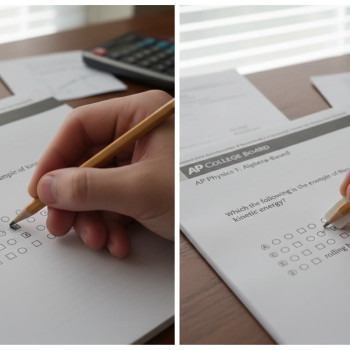Intro: Breathe. A Score Is Data, Not Destiny
It stings. You opened your AP score report, saw a number that didn’t match your hours of work, and felt that rush of disappointment—sometimes embarrassment, sometimes anger, sometimes numbness. If you’re reading this, you’re ready to turn that moment into momentum. A disappointing AP score doesn’t erase your effort or your potential. It gives you clear information: what went wrong, where you can improve, and how to target the right changes.
This article gives you a human, practical 30-day recovery plan. It’s for students who want to learn from the exam, rebuild confidence, and—if you choose—prepare to retake the AP next year or improve class performance. The approach is tactical, emotional, and realistic: one day at a time, with weekly goals, study templates, and a few proven mindset tools.

How to Use This 30-Day Plan
Before we jump into daily tasks, let’s set expectations. This plan assumes you recently received a score you want to improve. You can adapt it whether you plan to:
- Retake the same AP exam next year.
- Improve your understanding for class or college placement.
- Send or withhold scores to colleges (remember, College Board allows withholding or cancellation in specific windows—check deadlines if that’s on your mind).
Structure: Weeks 1–4 with daily checkpoints. Each week has a theme: Reflect, Rebuild, Practice, Polish. Slot the schedule into your life—30–90 minutes on school days, 2–4 hours on weekends. Consistency trumps marathon sessions.
Week 1 — Reflect: Turn Emotion Into Evidence (Days 1–7)
Day 1: Feel It, Then File It
Give yourself an hour to sit with the disappointment—sketch out what you felt, what surprised you, and one sentence of your long-term academic goal. Then switch to evidence mode. Pull up your College Board score report and any returned practice exams, essays, or class quizzes. Your brain needs both the emotional closure and the factual trail.
Day 2: Break the Score Down
AP score reports and returned tests tell a story. Look for sections or question types where you lost points. Did multiple-choice questions drag you down? Did the free response rub out your score because of timing or structure? Create a simple table (like the one below) to track patterns.
| Area | Evidence | Likely Cause | Immediate Fix |
|---|---|---|---|
| Multiple Choice | Got 40% correct on sample set | Weak on discrete content and timing | Targeted drills, timing practice |
| Free Response | Missing thesis, weak examples | Essay structure and evidence selection | Outline practice, rubric study |
| Calculator/Applied Section | Incorrect setups | Concept misunderstandings | Concept review, worked examples |
Day 3: Score Mapping — Where Did the Time Go?
Timing often sabotages otherwise-correct answers. Recreate the exam’s timing in a practice section and note where you slowed down. Was it reading passages, interpreting graphs, or planning essays? Flag those for drills.
Day 4: Read the Rubric (And Love It)
AP graders use rubrics. Spend today reading rubrics or scoring guidelines for each free-response task. Learn how points are awarded. This converts mystery into a checklist you can train to hit.
Day 5: Gather Resources and Support
Assemble a compact toolkit: your official College Board practice materials, class notes, a question bank, and 2–3 high-quality review videos or readings per topic you’re weak in. If you prefer guided help, consider brief 1-on-1 sessions—Sparkl’s personalized tutoring offers tailored study plans and expert tutors who can help you prioritize weaknesses quickly.
Day 6–7: Rest, Plan, and Set a Baseline Practice Test
Take a calm, timed practice exam (or at least a full-length section) to set a new baseline. Don’t aim to crush it—aim to collect data. Use the rest of this weekend to finalize your 30-day schedule based on the weak areas revealed.
Week 2 — Rebuild: Foundations and Concept Repair (Days 8–14)
Day 8–9: Concept Deep Dives
Focus on 1–2 high-leverage topics discovered in Week 1. Use active study: explain the concept aloud, teach it to a friend, or write a short cheat-sheet. Short, intense reviews beat passive reading.
Day 10: Targeted Practice Problems
Now solve 20–40 focused problems that practice the concept. Time each block. After each problem, write one line: Why was the answer correct? Why were the wrong options tempting? This reflection changes mistakes into learning.
Day 11: Strategy Day — Question Triage
Learn to triage questions during the exam: skip and mark confusing ones, return to high-yield questions, and estimate remaining time per section. Practice this during timed blocks.
Day 12: Free-Response Structure Lab
Pick 2–3 previous free-response prompts. Spend 10–15 minutes outlining a response, and then 15–25 minutes writing. Compare your answers to rubrics. Focus on structure—clear thesis, two or three well-supported points, and a strong conclusion.
Day 13: Mixed Practice and Error Log
Do a mixed problem set of 30–50 questions. Every mistake goes into an error log with a short correction. Over time, that log becomes a personalized review guide.
Day 14: Mini Mock and Reflection
End the week with a shorter timed mock (half an exam). Compare progress to your Week 1 baseline. Celebrate improvements—small wins fuel momentum.
Week 3 — Practice: Build Speed and Exam Habits (Days 15–21)
Day 15–16: Full-Length Practice Test
Take a full, simulated AP exam under realistic conditions. No phone, timed sections, real breaks. Afterward, score it using official rubrics and note remaining trouble zones.
Day 17: Tactical Fixes
Work solely on the top 2 persistent weaknesses from the mock. Use deliberate practice—intense, focused, immediate feedback.
Day 18: Time-Pressure Drills
Run multiple short drills that compress time: complete a full passage set in 75% of normal time, or write a free-response in 80% of the typical time. These drills train calm under pressure.
Day 19: Exam Day Logistics
Plan the non-academic side of your retake or next exam season. Know registration windows, score-send deadlines, calculator or permitted materials rules, and how to request score withholding or cancellation if you need it later. Confirm your test-day routine: wake-up time, breakfast, journey plan.
Day 20–21: Peer Review and Expert Check
Swap practice essays or problem sets with a classmate or teacher for feedback. If you have access to a tutor, these days are valuable for targeted 1-on-1 coaching. Personalized tutoring—like Sparkl’s 1-on-1 guidance—can accelerate corrections by tailoring feedback to your patterns and offering AI-driven insights into what to prioritize next.
Week 4 — Polish: Final Refinement and Confidence Building (Days 22–30)
Day 22–24: Final Topic Sweep
Review your error log and flashcards. Spend short, intense blocks (25–40 minutes) on each remaining weak topic. Keep practice mixed so you don’t overfit to one question type.
Day 25: One More Full Mock
Take another full simulated exam. Use identical conditions to your previous mock and compare. The goal is measurable progress: clarity in timing, fewer careless errors, stronger thesis statements. Celebrate the measurable gains.
Day 26: Test Strategy Refinement
Refine your exam-day script: first 5 minutes (read instructions, skim sections), middle phase (triage and answer in order of confidence), last phase (review flagged items). Practice this script in a small timed set.
Day 27: Micropractice — 20-Minute Power Sessions
Complete 3–4 power sessions of 20 minutes each: mixed MC, short FR outline, argument construction, and a quick data interpretation problem. These keep your brain sharp and reduce exam-day fog.
Day 28: Mindset and Relaxation
Performance isn’t just knowledge—it’s calm application. Practice breathing techniques, light exercise, and a sleep schedule that gives you consistent rest. Visualize walking into the exam with a plan, not panic.
Day 29: Logistics Check and Final Quick Review
Confirm registration, campus directions if testing in-person, or remote-testing setup. Pack your bag: photo ID, approved calculator, pencils, eraser, water. Do one last light review of your error log; do not cram new topics.
Day 30: Confidence Day
Do something to boost confidence—teach a friend a concept, rework a previous perfect problem, or take a short walk and reflect on progress. You’ll be ready whether you sit an official retake later or simply use these improvements in class and future assessments.
Weekly Schedule Template (Compact)
| Day | Focus | Time | Activity |
|---|---|---|---|
| Mon–Fri | Daily Blocks | 30–90 min | Targeted drills + review error log |
| Saturday | Mock or Deep Dive | 2–4 hrs | Full section or concept drill |
| Sunday | Reflection and Light Review | 1–2 hrs | Review mistakes and plan next week |
Practical Tools and Habits That Actually Work
- Error Log: A one-page living document where each mistake lives with cause and correction.
- Active Recall: Use flashcards and quick self-quizzes rather than re-reading notes.
- Spaced Repetition: Revisit errors at increasing intervals (2 days, 6 days, 14 days).
- Timed Drills: Practice with a timer. Pressure changes how you think.
- Teach It: If you can explain a concept in a five-minute mini-lesson, you own it.
Example: How This Works for AP Psychology
Imagine your free-response score was low because your examples were vague. Week 1 finds this; Week 2 rebuilds by working on specific studies and their application; Week 3 practices timed FRs and matching studies to prompts; Week 4 polishes by rehearsing 2–3 ready-to-use study examples. On test day, you’ll have crisp, labeled studies ready to deploy.
When to Consider a Retake—and the Administrative Bits
AP Exams are available once a year, and you can retake the exam in a subsequent year. If you plan to retake, check the registration window for your testing year and the score-sending deadlines for colleges you care about. If you want to prevent a lower score from being sent to a college, College Board provides options for withholding or canceling, but those have deadlines and procedures—so be aware and act quickly if that’s part of your plan.
How Personalized Tutoring Can Accelerate a Comeback
Some students do best with self-study; others need a guide to spot blind spots fast. Short, focused 1-on-1 tutoring can compress your learning curve: a tutor can diagnose recurring errors, model a rubric-worthy free response, and build a tailored study map. Services that combine expert tutors and data-driven feedback—like Sparkl’s personalized tutoring—can slot into this 30-day plan naturally, offering targeted sessions, tailored study plans, and even AI-driven insights to prioritize what to practice next.
Common Pitfalls and How to Avoid Them
- All-or-Nothing Thinking: One score doesn’t define you. Treat it as feedback.
- Over-Cramming: Late-night crams create brittle learning. Short, regular sessions are stronger.
- Ignoring Rubrics: Not matching your response to what graders reward wastes points.
- Neglecting Logistics: Missed registration or wrong calculator rules can derail months of work.
Keeping Motivation: Small Wins and a Growth Mindset
Track three types of wins: process wins (completed study blocks), knowledge wins (mastered topics), and mock-test wins (improved timing or score). Celebrate each. Replace “I failed” with “I tested a strategy that didn’t work and now I know what to fix.” Growth is iterative.
Final Checklist Before You Move Forward
- Have a clear list of problem areas from your score report.
- Converted rubrics into checklists for free responses.
- Built an error log and a 30-day calendar that fits your life.
- Done at least two full timed practice exams under realistic conditions.
- Decided whether you’ll retake, with registration and deadlines noted, or focus on class and future tests.
- Considered short targeted tutoring sessions if you need faster diagnostics—Sparkl’s tutors can be a helpful option for 1-on-1 guidance.

Parting Thought: This Month Is a Bridge, Not a Verdict
Thirty days is enough to change patterns, correct habits, and reclaim confidence. Whether you improve the score you send to colleges or simply become stronger in class, the process teaches how to learn from setbacks—arguably the most important skill you take into college and beyond.
If you want a customized 30-day calendar built for your particular AP subject and weak areas, say the subject and one or two trouble topics. I can draft a day-by-day plan you can print and follow—or outline how short, targeted tutoring sessions can plug into each week.



















No Comments
Leave a comment Cancel